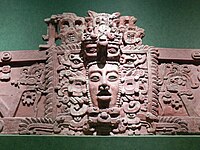Pulltrouser Swamp
This article, Pulltrouser Swamp, has recently been created via the Articles for creation process. Please check to see if the reviewer has accidentally left this template after accepting the draft and take appropriate action as necessary.
Reviewer tools: Inform author |
18°10′00.0″N 88°34′00.0″W / 18.166667°N 88.566667°W
Introduction
Pulltrouser Swamp is a wetland area located in northern Belize where several sites belonging to the Maya civilization are located[1].
Ceramics
Much of the sample ceramics recovered at Pulltrouser swamp are too small to clearly establish ceramic sequence or detailed understandings. However there is some useful information that can be gained from the ceramics that were found. There is a presence of Early and Moderate Classic sherds (pieces) that are mixed and disturbed. The pottery style of the few specimens (bowls and vessels) that could be identified is linked to coastal sites in Belize and sites from Becan to Lake Bakalar. The sites from Becan to Lake Bakalar are also sites where raised field agriculture is prevalent[2].
Stone Tools
The stone tools (or "lithics") at Pulltrouser Swamp suggest that their use was during occupation of the site from the Late Preclassic to Late Classic Period. The tools found at the site were mostly for agricultural use or manufacturing agricultural products. There is little evidence that any of the tools were manufactured at the site. The types of tools found consisted of oval bifaces, trunchet bits, celts, picks, beveled bits, blades, and hammers stones. The majority of the tools are made from chert with some of chalcedony, cherty-limestone and obsidian. The oval bifaces are made from chert sourced near the site of Colha, Belize; these tools have wear consistent with agricultural work and were most likely used as hoes. The tranchet bits arrived fully formed at Pulltrouser, although there is evidence of retouching at the site. There are also blades made of chalcedony, stemmed knives and battered tools, sixteen of them made from chalcedony and two of cherty-limestone[3]. Obsidian tools were mostly prismatic blades that were made from abraded surfaces and were sourced from Guatemala[4][5]. The lithics found at Pulltrouser suggest extensive trade with nearby sites, since there is little evidence of manufacturing at the site. In addition, many of the chert tools were recycled and reused suggesting that these items were highly valued.[6]
Notes
- ^ Turner, B.L. and Peter D. Harrison. Pulltrouser Swamp: ancient Maya habitat, agriculture, and settlement in northern Belize. Austin: University of Texas Press, 1971.
- ^ Turner, B.L. and Peter D. Harrison. Pulltrouser Swamp: ancient Maya habitat, agriculture, and settlement in northern Belize. Austin: University of Texas Press, 1971.
- ^ Turner, B.L. and Peter D. Harrison. Pulltrouser Swamp: ancient Maya habitat, agriculture, and settlement in northern Belize. Austin: University of Texas Press, 1971.
- ^ Turner, B.L. and Peter D. Harrison. Pulltrouser Swamp: ancient Maya habitat, agriculture, and settlement in northern Belize. Austin: University of Texas Press, 1971.
- ^ McAnany, Patricia, 1989. Stone-Tool Production and Exchange in the Eastern Lowlands: The Consumer Perspective from Pulltrouser Swamp, Belize. American Antiquity, 54(2), p.332-346.
- ^ Turner, B.L. and Peter D. Harrison. Pulltrouser Swamp: ancient Maya habitat, agriculture, and settlement in northern Belize. Austin: University of Texas Press, 1971.
References
- Turner, B.L. and Peter D. Harrison, 1971. Pulltrouser Swamp: ancient Maya habitat, agriculture, and settlement in northern Belize. Austin: University of Texas Press.
- McAnany, Patricia, 1989. Stone-Tool Production and Exchange in the Eastern Lowlands: The Consumer Perspective from Pulltrouser Swamp, Belize. American Antiquity, 54(2), p.332-346.



